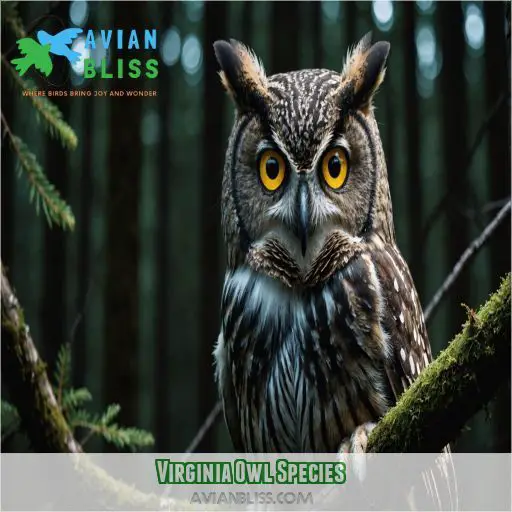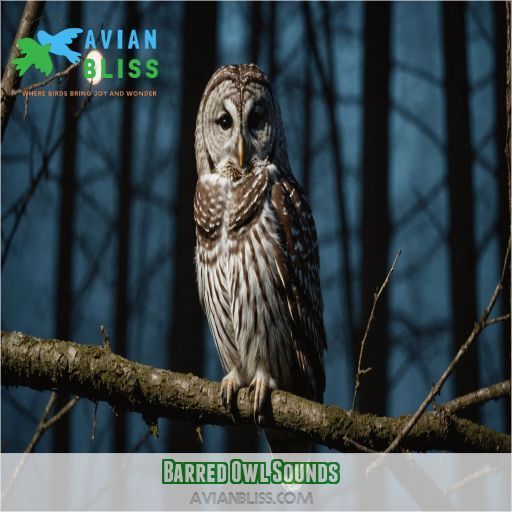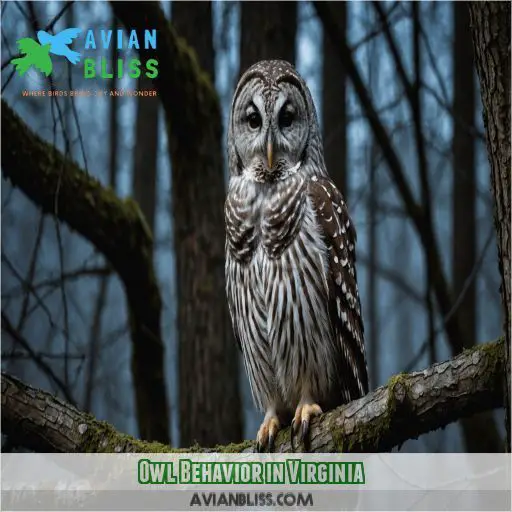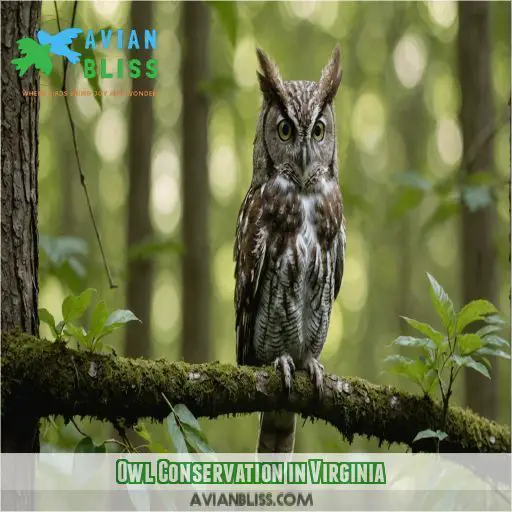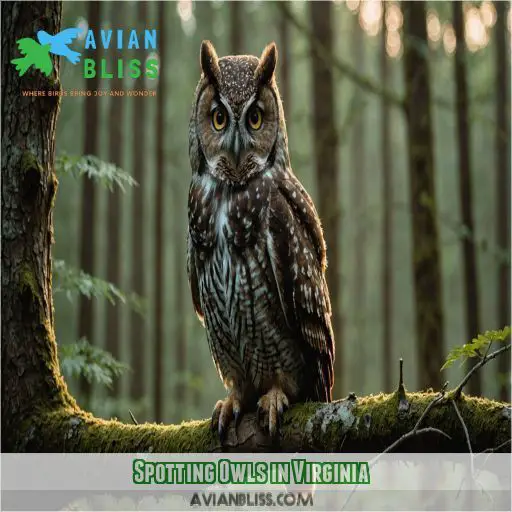This site is supported by our readers. We may earn a commission, at no cost to you, if you purchase through links.
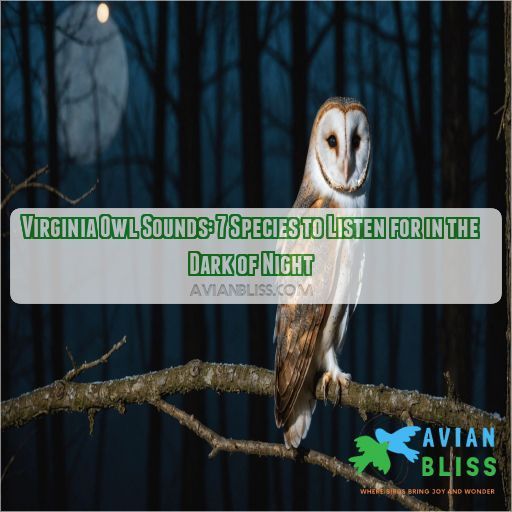 When you venture into Virginia’s forests at night, you’ll be treated to a symphony of owl sounds.
When you venture into Virginia’s forests at night, you’ll be treated to a symphony of owl sounds.
From the iconic "Who cooks for you?" call of the Barred Owl to the eerie whinny of the Eastern Screech-Owl, these nocturnal creatures have quite the repertoire.
You might hear hoots, whistles, trills, and even some bone-chilling screeches.
Each species has its own unique vocal fingerprint, like nature’s version of a nighttime radio show.
With a bit of practice, you’ll be able to distinguish between the seven owl species that call Virginia home.
Table Of Contents
- Key Takeaways
- Virginia Owl Species
- Owl Calls in Virginia
- Barred Owl Sounds
- Identifying Owl Calls
- Owl Behavior in Virginia
- Owl Conservation in Virginia
- Spotting Owls in Virginia
- Owl Mystique and Folklore
- Frequently Asked Questions (FAQs)
- What sounds do owls make in Virginia?
- What is the most common owl in Virginia?
- Which owl makes a hoo hoo sound?
- What does it mean when an owl is hooting outside your house?
- How do Virginia owls adapt their calls to urban environments?
- Can owl calls predict weather patterns in Virginia?
- Do Virginia owls mimic other bird species calls?
- How do seasonal changes affect owl call frequency?
- Are there regional dialects in Virginia owl populations?
- Conclusion
Key Takeaways
- Virginia’s forests are a veritable owl karaoke bar at night, with seven species belting out their unique tunes – from the Eastern Screech-Owl’s horse-like whinny to the Barred Owl’s famous "Who cooks for you?" hit single.
- Becoming an owl call expert is like learning nature’s secret language. With a bit of practice, you’ll be decoding hoots, whistles, and screeches faster than you can say "nocturnal detective."
- These feathered night owls aren’t just making noise for the heck of it. Their calls serve as pick-up lines, territory markers, and even alarm systems. It’s like Twitter for birds, but way cooler.
- While owl-watching can be a hoot, remember to play it safe and respect their space. No one likes a spotlight in their eyes, especially not when they’re trying to catch dinner!
Virginia Owl Species
You’re about to meet the nocturnal neighbors you never knew you’d – seven owl species that call Virginia home, each with its unique sounds and characteristics. From the Eastern Screech-Owl’s whinny to the Barred Owl’s haunting "Who cooks for you?" call, you’ll learn to recognize and appreciate the distinct vocalizations of these mysterious birds.
Eastern Screech-Owl
The Eastern Screech-Owl, a common Virginia owl species, has a distinct set of calls.
- Habitat & Description: Found east of the Rockies, these owls are relatively small with reddish-brown or gray plumage, blending seamlessly with tree bark. They’re common in suburban neighborhoods, but their populations are declining in some areas.
- Calls: You’ll hear a descending, horse-like whinny for territory defense, and an extended trill on a single pitch for mating and contact calls.
- Diet & Nesting: Screech-owls feast on insects, small mammals, birds, and even amphibians, and they nest in cavities, often using old woodpecker holes.
Barred Owl
Now that you’re familiar with the Eastern Screech-Owl, let’s move on to the charismatic Barred Owl.
Common in Virginia, this owl’s distinctive "Who cooks for you?" call is a dead giveaway.
Barred Owls inhabit mature forests, woodland edges, and even urban parks.
Listen for their haunting calls at dawn or dusk, and keep an ear out for their rattling, cackling sounds during courtship.
Barn Owl
As you step out into the darkness, keep an ear out for the barn owl‘s haunting screech. These nocturnal birds are common in Virginia, with a diet of voles, mice, and other small mammals. You might just catch a glimpse of their ghostly form swooping over open fields.
- Imagine the barn owl’s wings beating softly as it hunts for prey under the light of the moon.
- Picture the owl’s distinctive heart-shaped face and white underside as it perches on a fence post.
- Envision the desolate landscape of an abandoned barn, the perfect hideout for these mysterious birds.
Short-Eared Owl
When you’re out in Virginia’s grasslands at dusk, listen for the Short-Eared Owl‘s distinctive "kek-kek-kek" or "hoo-h’ooh" calls. These birds migrate to the state for winter, feasting on small mammals and birds. Habitat loss and fragmentation threaten their populations, making conservation efforts really important. Pay attention to juvenile calls, often a series of high-pitched squeaks, a sign of breeding success.
Long-Eared Owl
You’re out in the woods, and a soft "hoo-h’ooh" echoes through the trees. It’s a Long-Eared Owl, its haunting call a giveaway. These owls inhabit dense forests, where they hunt small mammals and roost in tree cavities. Listen for their low, whistled calls, often in a series of 2-4 hoots. Be patient, as they’re nocturnal and rarely seen.
Northern Saw-Whet Owl
The Northern Saw-Whet Owl is a common winter visitor to Virginia, and some even choose to stay and breed. With a conservation status of Least Concern, these owls are:
- Small and stocky, with a brown or reddish color.
- Known for their high-pitched, raspy, and whistled toots, often in a repeated series.
- Masters of disguise, blending seamlessly with their surroundings, making them challenging to spot.
Snowy Owl (Rare)
The Snowy Owl, a rare treat for Virginia birders, occasionally graces the state during winter. These owls are typically seen when there’s a food shortage further north.
| Snowy Owl Habitat | Virginia Sightings | |
|---|---|---|
| 黎 | Tundra, open areas | Mt. Crawford/Bridgewater |
| | Lemmings, rodents | 3 sightings since 2013 |
| 吝 | Migrate to open spaces | Seen 1.5 miles apart |
Owl Calls in Virginia
As you step outside into the Virginia night, you’re likely to hear a chorus of owl calls, each one a unique identifier of the species that’s making it.
By learning to recognize these calls, you’ll be able to tell which owls are lurking in the darkness.
From the haunting hoots of the Barred Owl to the whinnying calls of the Eastern Screech-Owl, each species has its own distinct vocalization.
Hooting Calls
When listening for hooting calls in Virginia, you’re likely to hear the Eastern Screech-Owl‘s descending whinny or the Barred Owl‘s distinctive "Who cooks for you?" call. Hooting calls serve as a form of communication, territory defense, and mate attraction. Pay attention to variations in pitch, tone, and frequency to identify the owl species.
Whinny Calls
When you’re learning about owl sounds, you’ll often hear the whinny call, a distinctive sound that’s both fascinating and essential to understanding these nocturnal birds. Here are three key things to know about whinny calls:
- Whinny Call variations: The whinny call is a characteristic sound of the Eastern Screech-Owl, but it’s not the only owl species that makes this noise. Other owls, like the Great Horned Owl, may also produce similar sounds, although with distinct variations.
- Owl call mimicry: Whinny calls serve as a form of communication among owls, particularly for territorial defense and attracting mates. By mimicking these calls, you can attract owls for observation or research purposes.
- Whinny call purpose: Whinny calls are an essential part of owl behavior, helping these birds establish territories, find mates, and warn off predators. By listening to these calls, you can gain insight into the secret lives of owls and better understand their behavior.
Trill Calls
You’re in the woods, and suddenly, a high-pitched trill echoes through the trees. It’s an owl’s trill call! These calls are a series of rapid, musical notes used for contact and communication. Let’s break it down:
| Trill Call Variations | Owl Trill Frequency | Trill Call Response |
|---|---|---|
| Eastern Screech-Owl: 4-6 notes | 1-2 kHz | Mate or family response |
| Barred Owl: 2-4 notes | 2-3 kHz | Territorial warning |
| Barn Owl: 6-8 notes | 3-4 kHz | Contact call |
| Great Horned Owl: 2-3 notes | 1-2 kHz | Alarm call |
Now, listen for these trill calls in the Appalachian Mountains or Shenandoah National Park!
Screeching Calls
Listen for the Eastern Screech-Owl‘s high-pitched, descending whinny in Virginia’s woods. This screeching call is a territorial defense mechanism, often used by males to establish dominance. You might hear it in Shenandoah National Park or the Appalachian Mountains, where screech owls thrive. Visit the Macaulay Library to learn more about screech owl identification and conservation.
Other Vocalizations
You’ve learned to recognize the screeching calls of Virginia’s owl species, but there are more vocalizations to discover. Other owl sounds include:
- Snapping: a sharp, bill-snapping sound used by owls like the Barred Owl
- Chirping: a high-pitched sound made by young owls, like the Barn Owl
- Hissing: a defensive sound used by owls like the Great Horned Owl
- Grunting: a low, guttural sound made by owls like the Long-eared Owl
Barred Owl Sounds
You’re about to enter the haunting world of Barred Owl sounds, where the iconic "Who cooks for you?" call will become your new favorite earworm. As you explore the vocal repertoire of these Virginia residents, you’ll discover a range of sounds that will make you laugh, wonder, and maybe even inspire you to try some amateur owl impressions.
Iconic Who Cooks for You? Call
You’re in for a treat! The Barred Owl’s "Who cooks for you?" call is a distinctive series of 8-9 hoots that echoes through the forest.
Often described as a duet, this call is a key identifier of the species.
It can be heard throughout their range, from the Appalachian Mountains to British Columbia.
Try imitating the call, but beware of misidentifications!
The Barred Owl’s Song
While the "Who cooks for you?" call is the Barred Owl’s claim to fame, it’s just the tip of the iceberg.
These feathered maestros have a whole repertoire up their sleeves.
Their song evolves throughout the year, with variations that’ll keep you on your toes.
At places like Chincoteague National Wildlife Refuge or Kiptopeke State Park, you might catch a duet that’ll make your heart soar.
It’s nature’s symphony at its finest!
Courtship Calls
You’re in for a treat when Barred Owls start their courtship calls.
It’s like a wild party in the trees!
These lovebirds belt out a "riotous duet" that’ll make your head spin.
From cackles to hoots, caws to gurgles, they’ve got it all.
This vocal rollercoaster isn’t just for show – it’s how they bond and choose mates.
Keep your ears peeled during breeding season for this avian symphony!
Bill Snapping Sounds
While Barred Owls are known for their melodious calls, they’ve got another trick up their feathery sleeves.
When things get heated, these birds resort to bill snapping – a sharp, clicking sound that’s their way of saying, "Back off!"
You might hear this during territorial squabbles or when they’re protecting their young.
It’s like nature’s version of cracking your knuckles before a fight!
Identifying Owl Calls
You’re ready to become a nocturnal detective, but can you tell a barred owl from a barn owl? Let’s explore how to identify Virginia’s owl calls, so you’ll know exactly who’s hooting in your backyard tonight.
Recognizing Hoots and Whistles
Ready to become an owl call expert?
You’ll need to train your ears for a symphony of hoots and whistles.
Each owl species has its own unique vocal fingerprint.
Listen for variations in pitch, rhythm, and duration.
Some calls are deep and resonant, while others are high-pitched and eerie.
With practice, you’ll start picking up on subtle patterns and frequencies.
It’s like learning a secret language of the night!
Distinguishing Between Species
Now that you’ve got the basics down, let’s tackle the tricky part: telling those hoots apart! Each owl species in Virginia has its own unique vocal fingerprint. It’s like learning a new language, but instead of words, you’re decoding nature’s nighttime symphony. Here are some key differences to listen for:
- Eastern Screech-Owl: Think of a horse’s whinny, but spookier
- Barred Owl: The classic "Who cooks for you?" interrogator
- Great Horned Owl: Deep, resonant hoots that sound like a bass drum
- Barn Owl: Eerie screeches that could star in a horror flick
- Northern Saw-whet Owl: Repetitive toots, like a tiny truck backing up
Tips for Listening
Now that you’ve got the hang of distinguishing owl species, let’s sharpen your listening skills.
Grab your smartphone and download a sound recording app – it’s like having a pocket-sized owl expert!
When you’re out at night, find a quiet spot and let your ears do the work.
Use audio guides to familiarize yourself with different calls.
Owl Behavior in Virginia
When you’re out in Virginia’s forests at night, you’re not just hearing random hoots and screeches—you’re eavesdropping on a complex world of owl behavior. From territorial disputes to romantic serenades, the sounds of Virginia’s owls offer a fascinating glimpse into their nocturnal lives.
Nocturnal Habits
Now that you can identify owl calls, let’s peek into their moonlit world. Virginia’s owls are true night owls, with some fascinating nocturnal habits:
- Nighttime foraging: They hunt when most creatures sleep.
- Unique sleep patterns: Many owls catch daytime Z’s in tree hollows.
- Moonlight impact: Brighter nights often mean more owl activity.
- Sensory superpowers: Their eyes and ears are fine-tuned for darkness.
These feathered ninjas have mastered the art of nightlife. Ever wonder how they navigate so silently?
Territory Defense
As night falls, Virginia’s owls shift from their quiet daytime demeanor to active territory defenders. You’ll hear a symphony of hoots and calls as they stake their claims. These vocal threats aren’t just for show – they’re serious business in the owl world. Check out this quick guide to some common territorial behaviors:
| Behavior | Purpose | Example Species |
|---|---|---|
| Hooting | Long-distance communication | Great Horned Owl |
| Bill-snapping | Close-range intimidation | Barred Owl |
| Silent flight | Surprise approaches | Barn Owl |
Mating and Breeding
As the days grow longer, Virginia’s owls shift from territorial tussles to more amorous affairs.
You’ll hear their love songs echoing through the night as they seek out mates.
Once paired up, these feathered lovebirds get busy finding the perfect nesting spot.
From hollow trees to abandoned barns, each species has its preferred love nest.
Soon enough, tiny owl chicks will be peeking out, hungry for their next meal.
Hunting and Feeding
Once the owls have paired up, it’s time to fill those hungry bellies!
Virginia’s owls are nature’s night-shift exterminators, keeping rodent populations in check.
Their hunting techniques are as silent as a whisper, thanks to specialized feathers that muffle the sound of their flight.
You might hear a swoosh or a soft thud as they snag their prey, but blink and you’ll miss it!
Owl Conservation in Virginia
As you listen for Virginia’s nocturnal hoots and calls, it’s important to remember the challenges these fascinating creatures face. From shrinking habitats to climate change impacts, Virginia’s owls need our help to make sure their haunting songs continue to echo through the night for generations to come.
Habitat Loss and Fragmentation
As you’ve learned about owl behavior, you might wonder how these nocturnal creatures are faring in our changing world. Sadly, habitat loss and fragmentation are major threats to Virginia’s owls. Urban sprawl and development are gobbling up their homes faster than you can say "who cooks for you?" Here’s what’s happening:
- Forests are being chopped up into smaller patches
- Old trees with nesting cavities are disappearing
- Hunting grounds are shrinking
- Light pollution is disrupting owls’ night vision
- Noise pollution is interfering with their keen hearing
Climate Change Impacts
Climate change is throwing owls for a loop, too.
As temperatures shift, you might notice changes in owl migration patterns and habitat preferences.
It’s like they’re playing musical chairs with their homes!
This shuffle affects food availability and breeding seasons, potentially causing owl populations to yo-yo.
Keep an eye out for these changes – you could be witnessing nature’s real-time response to our warming world.
Vehicle Collisions
You’ve probably seen those eerie eyes reflecting in your headlights at night.
Owls often hunt near roads, putting them at risk of collisions.
To help our feathered friends, slow down in wooded areas and keep an eye out for low-flying silhouettes.
Some areas have installed "owl crossings" with special signs and reduced speed limits.
Poisoning Risks
While collisions pose a risk, another silent killer lurks in our backyards.
Rodenticides, used to control pests, can have devastating effects on owls.
When these birds snack on poisoned rodents, they’re unknowingly ingesting toxic chemicals.
It’s a domino effect that ripples through the food chain, threatening owl health and populations.
Research and Monitoring
- Participate in citizen science projects like owl surveys
- Help set up acoustic monitoring devices to capture owl calls
- Crunch numbers with researchers to analyze population trends
Spotting Owls in Virginia
Ready to go on a nocturnal adventure in Virginia? With seven owl species to discover, you’re in for a hoot as we explore the best ways to spot these elusive birds in their natural habitats.
Best Times for Observation
Now that we’ve covered conservation, let’s talk about when you’re most likely to hear those hoots and whistles. Timing is key when it comes to owl-watching. Here’s a handy guide to help you plan your nocturnal adventures:
| Season | Best Time | Moon Phase |
|---|---|---|
| Winter | Dusk-10PM | New Moon |
| Spring | 3AM-Dawn | Full Moon |
| Summer | 9PM-11PM | Waxing |
| Fall | Sunset-8PM | Waning |
| All | Cloudy | Any |
Ideal Locations
Looking to spot owls in Virginia? You’re in luck! The Old Dominion offers plenty of prime owl-watching spots. Here are four ideal locations to start your nocturnal adventure:
- Virginia state parks, where nature’s night shift comes alive
- Suburban backyards, where owls might be closer than you think
- Forested areas, the ultimate owl hangout spots
- Near water sources, where owls often hunt for prey
Tips for Observation
Now that you’ve found a great spot, let’s talk about how to spot these elusive night birds.
Keep your eyes peeled for silhouettes against the night sky, and your ears open for their distinctive calls.
Bring along a pair of binoculars and a red-light flashlight to avoid disturbing them.
Safety Precautions
When you’re out owl-spotting, remember: safety first!
Keep a respectful distance—these night hunters need their space.
Tread lightly and speak softly; sudden noises might spook them.
Bring a buddy and a flashlight, but resist the urge to shine it directly at the owls.
It’s like someone flashing high beams in your eyes—not cool!
Stay on marked trails and leave the habitat as you found it.
Happy hooting!
Owl Mystique and Folklore
As you listen for owl calls in Virginia’s dark forests, you’re tapping into a rich tapestry of mystique and folklore. These nocturnal birds have captivated human imagination for centuries, inspiring myths, symbols, and cultural beliefs that add an extra layer of intrigue to their haunting sounds.
Cultural Significance
You’ve probably heard that owls are wise, but did you know they’re steeped in cultural significance too?
From Native American traditions to ancient beliefs, these nocturnal birds have captured our imaginations for centuries.
In Virginia, owls have played roles in local folklore and superstitions.
Ever wonder why some folks get spooked by an owl’s hoot? It’s all part of the rich tapestry of owl mystique!
Symbolism and Myths
Beyond their cultural significance, owls have long been steeped in symbolism and myth.
You might have heard that they’re wise old souls, but did you know some Native American tribes see them as spirit guides?
In European folklore, they’re often linked to magic and mystery.
Victorian literature painted them as omens of doom.
Whether you see them as wise or wicked, owls certainly know how to keep us guessing!
Historical Associations
Owls have deep historical roots, going beyond myths.
You’ll find them in ancient Egyptian hieroglyphs and Greek legends.
They’ve been both feared and revered, seen as wise sages or harbingers of doom.
In Virginia, Native American tribes often associated owls with spiritual guidance.
Whether you’re a history buff or nature lover, understanding these historical ties adds another layer to your owl-listening adventures.
It’s like eavesdropping on centuries of human imagination!
Frequently Asked Questions (FAQs)
What sounds do owls make in Virginia?
You’ll hear a range of owl sounds in Virginia, from the Eastern screech owl‘s eerie whinny to the barred owl’s "Who cooks for you?" call. Listen for the great horned owl’s deep hoots and the barn owl’s chilling shriek.
What is the most common owl in Virginia?
You’d think the most common owl in Virginia would be a hoot, but it’s actually the Eastern Screech-Owl. Don’t let its name fool you—it’s more of a triller than a screamer. You’ll find these pint-sized predators in woodlands statewide.
Which owl makes a hoo hoo sound?
You’ll often hear the Great Horned Owl making that classic "hoo-hoo" sound. It’s their signature call, deep and resonant. Listen closely on quiet nights – you might catch this nocturnal crooner serenading the moonlit forest.
What does it mean when an owl is hooting outside your house?
You’re not alone, you’re not in danger, and you’re about to learn something fascinating. When an owl hoots outside your house, it’s likely marking its territory, searching for a mate, or communicating with other owls nearby.
How do Virginia owls adapt their calls to urban environments?
You’ll notice Virginia’s owls adjusting their calls in urban areas. They’re adapting to the city’s noise by making their hoots louder and higher-pitched. It’s like they’re shouting over traffic to be heard!
Can owl calls predict weather patterns in Virginia?
Imagine a moonlit forest, alive with hoots and calls. You might wonder if owls predict weather, but there’s no scientific evidence. Their vocalizations are more about communication and territory than forecasting storms. Still, nature’s symphony remains fascinating.
Do Virginia owls mimic other bird species calls?
You’ll be surprised to learn that some Virginia owls are talented mimics! While not common, certain species can imitate other birds’ calls. It’s nature’s way of keeping you on your toes during nighttime owl-watching adventures.
How do seasonal changes affect owl call frequency?
You’ll hear more owl calls during winter, especially in January and February. As the breeding season kicks off, owls get chatty. They’re looking for love and defending territory, so their hoots and trills fill the night air.
Are there regional dialects in Virginia owl populations?
You’ll find owl dialects fascinating! While regional variations aren’t well-documented in Virginia, individual owls may have unique calls. Listen closely – you might catch subtle differences in pitch or rhythm between owls in different areas.
Conclusion
Who knew that Virginia’s nighttime soundtrack could rival a monster movie?
But fear not, those eerie calls are just our feathered friends engaging in some nocturnal networking.
Now that you’re equipped with knowledge about Virginia owl sounds, you’re ready to decode the nightly symphony.
So grab your binoculars, tune your ears, and head out into the darkness.
Who knows? You might just become the next great owl whisperer.
Just remember, when an owl asks "Who?", it’s not an existential crisis—it’s just saying hello!

